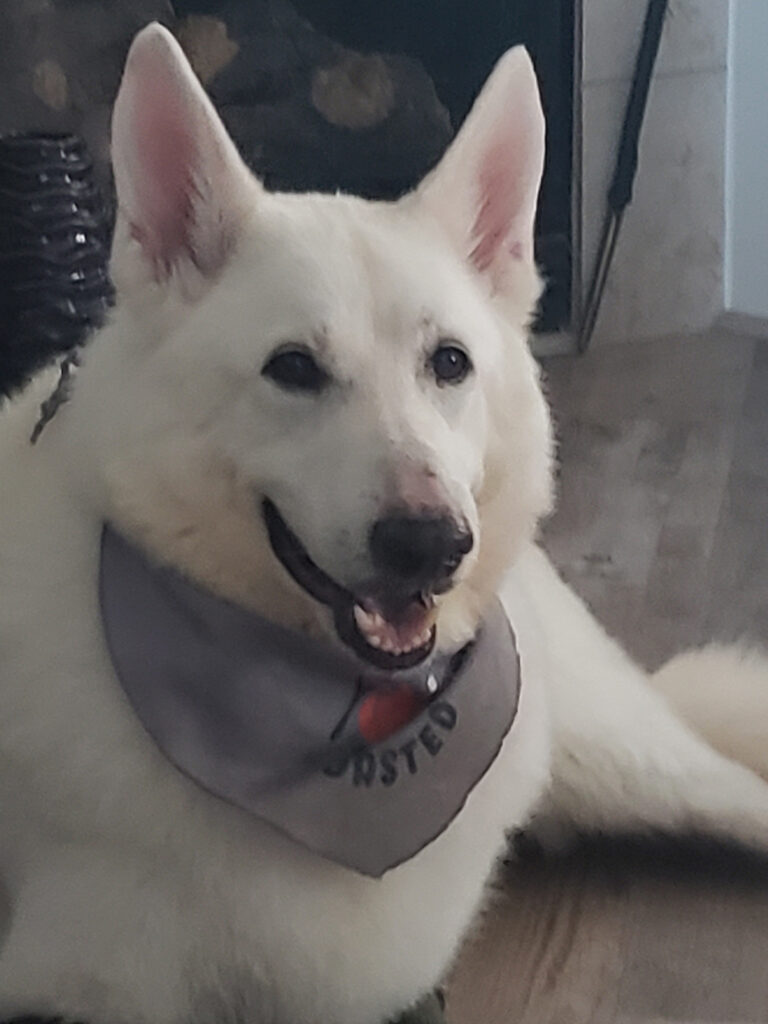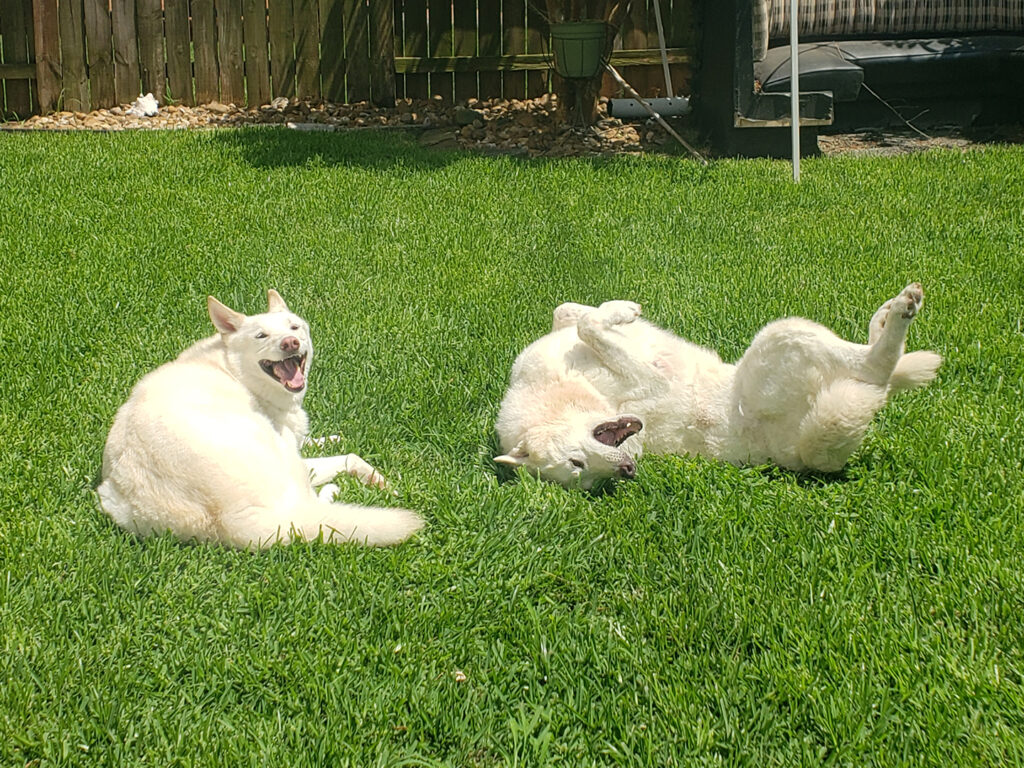Texas A&M Veterinarians Heal U.S. Army Soldier’s Dog After Life-Threatening Tongue Injury
Story by Megan Myers, VMBS Communications

Four years ago, United States Army soldier Francesca Salinas received a call from a military friend with an urgent plea — a beautiful, white German Shepherd at a local pound was going to be put to sleep if he wasn’t adopted that day.
Despite the dog’s unknown background, the choice was an easy one for Salinas. She, her newly rescued German Shepherd, Ranger, and her other dog, Captain, immediately developed a strong bond and have been inseparable ever since.
But when a mysterious accident occurred while Salinas was out of town, their determination to stay together was put to the test, and it would end up taking a team of surgeons at the Texas A&M Small Animal Teaching Hospital (SATH) to ensure the trio was reunited.
A Rare Injury
Salinas was working on an oil rig when she received a disturbing call from her pet sitter — Ranger had somehow injured his tongue and had been rushed to a veterinary clinic, but the doctors weren’t sure if the injury could be healed.
“I was in the middle of the Gulf of Mexico when they called me, so I had to call in two choppers and a plane to come pick me up,” she said. “I just said, ‘Do not touch him until I get back.’ I was determined to not give up on him, and I knew he would be determined too.”
Once back in her hometown of Tomball, the severity of Ranger’s injury became clear. The veterinarians believed he somehow got his tongue stuck inside a toy, leading to a serious amount of necrosis, or lack of blood supply causing death to the cells, of the tongue’s tissue.
The clinic’s only suggestion was to bring Ranger to Texas A&M University for a second opinion, so Salinas loaded him up and immediately drove to College Station.
Upon arrival, her determination paid off right away — Ranger’s veterinary team knew exactly how to save him.
“The tongue’s tissue was dead, so it needed to be taken off,” said Dr. Kelley Thieman, an associate professor and the Nancy & Michael Shaw ’68 Chair in Small Animal Clinical Sciences at the Texas A&M School of Veterinary Medicine & Biomedical Sciences (VMBS).
“It really came down to us having the team and supplies necessary to be able to do that procedure,” she continued. “I can’t say enough about having a full, fantastic team that’s used to working together. That enables us to do a lot of things other veterinary practices might not be able to do.”
Leaving Ranger at the hospital for his procedure was difficult for Salinas, but she knew that she had found him a care team that would treat him like their very own.
“They were there with me every step of the way and they didn’t give up on him. They kept me apprised of everything that was happening; from the time I dropped him off to every time they did rounds, they would send me updates on how he was doing,” she said. “From the way they treated him, I knew they cared as much as I cared. I really, really appreciate that from the bottom of my heart.”
A Complete Recovery

Tongue resections aren’t very common in veterinary medicine and those that do happen are usually because of a tumor forming on the tongue or diabetes causing the end to die off.
“This case was unusual because he was otherwise healthy and just had a freak accident,” Thieman said. “This may have been the first tongue resection I’ve ever done for an injury caused by a toy.”
Fortunately, the procedure was relatively straightforward, and Thieman’s fellow soft tissue surgeon, Dr. Jacqueline Davidson, was available to perform the tongue resection the following day.
“The tongue is super vascular, so it bleeds a lot,” Thieman said. “We place a gentle clamp across the tongue to decrease the blood flow, and then we just resect the dead part and stitch the edges together so that it comes back in a functional, rounded tongue shape.”
In the end, Ranger lost about half his tongue from the injury.
Fortunately, dogs are highly adaptable and can easily learn to work around impairments.
“Dogs have a lot of tongue and because they don’t speak like humans do, they don’t really need all of it to function,” Thieman said. “What tongue he has left is alive and functional, so he can still feel and taste with it. He may be a messy eater and drinker, but he can do it happily and pain free.”
After spending a week at the SATH recovering and learning how to eat and drink with a smaller tongue, Ranger returned home to continue his recovery.
“He learned just the way that the surgeon explained it to me,” Salinas said. “He learned to eat like a horse; horses don’t really use their tongue, but they still eat and drink water. He just learned how to slurp up the water and food instead.”
Although removing so much of the tongue seems like it ought to have an impact on Ranger’s taste preferences, Salinas said he is more than happy to eat “anything and everything,” just like before the surgery.
Because Salinas is an active member of the Army, she also received monetary assistance through the VMBS’ Veterinary Valor Program to support Ranger’s care.
“I was very grateful that they gave me good pricing for him and that they took care of him,” Salinas said. “If you see the before and after pictures, you will not believe it. Everybody thought that he wasn’t going to make it. But it did not affect him whatsoever, having half of his tongue removed. He’s happy, joyful, and actually eats and drinks more than his brother!”
###
For more information about the Texas A&M College of Veterinary Medicine & Biomedical Sciences, please visit our website at vetmed.tamu.edu or join us on Facebook, Instagram, and Twitter.
Contact Information: Jennifer Gauntt, Director of VMBS Communications, Texas A&M College of Veterinary Medicine & Biomedical Sciences, jgauntt@cvm.tamu.edu, 979-862-4216


